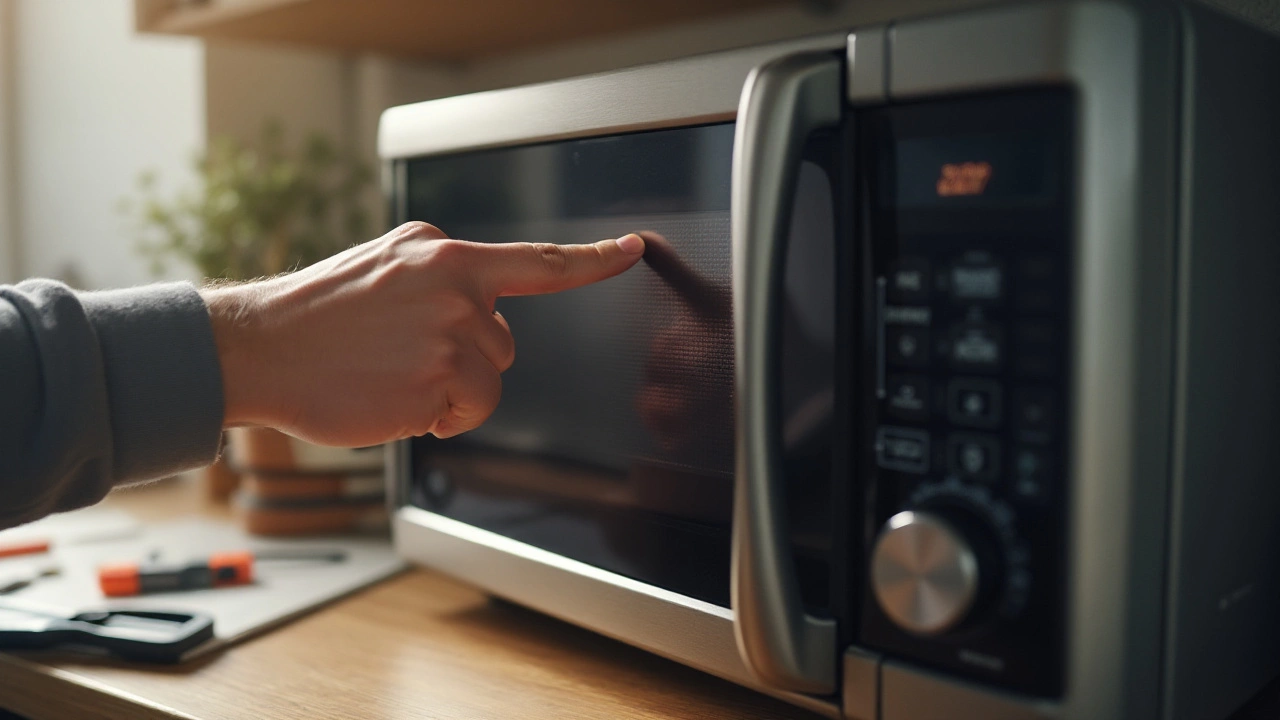Microwaves are a staple in modern kitchens, known for their convenience and efficiency in reheating and cooking food quickly. But just like any other appliance, they come with a finite lifespan. How long should you expect your microwave to serve you?
In this article, we'll explore the various aspects that determine how long your microwave can last. From daily usage habits to maintenance routines, many factors play a role in this. We’ll also share insights into recognizing the signs that your microwave might be nearing the end of its journey and offer handy tips to ensure you get the most out of your trusty kitchen companion.
Read on to get all the details you need to keep your microwave running smoothly and efficiently, and to know when it might be time to start considering a new purchase.
- The Average Lifespan of a Microwave
- Factors That Affect Microwave Longevity
- Signs Your Microwave Needs Attention
- Tips to Extend Your Microwave's Life
- Common Microwave Issues and Solutions
- When to Consider Replacing Your Microwave
The Average Lifespan of a Microwave
Microwaves, a quintessential part of our fast-paced lives, usually come with an expected lifespan that many consumers might not be aware of. Generally speaking, the average microwave lasts about ten years. This span can vary, of course, depending on several factors including usage patterns and the frequency of maintenance. One should remember that this is an average figure – individual experiences can differ, with some appliances serving well past the decade mark, while others might give out much sooner.
It's intriguing to note how the frequency and manner of use impact the microwave lifespan. Microwaves used once or twice a day typically endure longer compared to those subjected to regular heavy usage throughout the day. As part of proper maintenance, simply keeping the appliance clean and ensuring the air vents aren't blocked can significantly contribute to its longevity. The choice between different microwave brands can also be pivotal, as some are designed with superior materials and technology that lend them a longer life. A compelling insight shared by Consumer Reports notes, "Most microwaves are replaced not because they stop working, but because homeowners opt for newer models or styles."
When you consider factors like how often you defrost, cook, or reheat meals daily, it's clear that the life expectancy of the microwave can vary greatly. Moreover, it's interesting how technological advancements have affected the performance of microwaves, shifting the typical lifespan with more durable and efficient models emerging. Evidently, a combination of taking care of the appliance and making an informed choice at the point of purchase plays a crucial role in determining how long your appliance will last.
Another interesting aspect is how external conditions like power surges or placement in relation to other kitchen appliances can subtly influence a microwave's life. A microwave tips consideration involves placing it somewhere with proper ventilation and protection against unexpected power interruptions. This strategic positioning can prevent overheating or sudden damage. As with many household appliances, knowing these subtleties is as important as understanding the core function and maintenance needs.
| Usage Type | Years |
|---|---|
| Light Usage | 10-12 years |
| Moderate Usage | 8-10 years |
| Heavy Usage | 5-7 years |
Factors That Affect Microwave Longevity
When considering the microwave lifespan, a myriad of factors come into play, each influencing how long your trusty kitchen gadget can keep up with the demands of daily life. First up on the list is the frequency of use. Microwaves used multiple times a day in bustling households will naturally experience more wear and tear compared to those used sporadically in a quiet, single-person dwelling. Regularity of use often correlates with quicker deterioration, making it crucial to observe maintenance practices diligently.
Material quality and brand reputation also significantly influence a microwave's potential lifespan. Higher-end models often boast better internal components and sturdier exterior materials, promising a longer service life. Brands well-known for their durable home appliances tend to pour more resources into the longevity and reliability of their products. An exemplary model could hum along efficiently for over a decade while cheaper alternatives may struggle to reach the half-decade mark.
Another critical factor is the nature of the tasks your microwave performs. If you're consistently pushing your appliance to its limits—defrosting large volumes, running on high power, or using it for non-standard purposes—this strains the device. Overloading your microwave or running it empty can severely impact the appliance’s shelf life. It’s not just how often you use your microwave that matters, but how demanding the applications are.
"Microwaves tend to break down faster if they're used for heating processes they're not designed for," notes appliance expert Jane Austin from Kitchen Excellence Magazine.
Additionally, the environment in which your microwave resides plays a subtle yet impactful role. Excessive humidity, dust, or grease from nearby cooking operations can infiltrate and corrode internal components. Ensure your microwave is positioned in a well-ventilated space and is routinely cleaned to prevent these elements from taking a toll on its internal parts.
Let’s not forget the power supply! If your home experiences frequent electrical surges or has wiring issues, this can wreak havoc on your microwave’s circuit board. Consider investing in a surge protector for added safety. Routine electrical inspections can further preempt this issue, saving your appliance from potential electrical damages.
Understanding what goes into extending or curtailing your microwave's life can be the key to making it last. Armed with this knowledge, homeowners can make smarter decisions on use, maintenance, and even purchases in the future, ensuring that their kitchen remains well-equipped and functional.

Signs Your Microwave Needs Attention
Microwaves are incredibly convenient, but they are not invincible. Over time, these handy kitchen appliances can begin to show signs that they need some tender loving care. Recognizing these signs early can save you a world of hassle. Have you noticed that your microwave stops halfway through a cooking cycle, or it doesn't start at all unless you slam the door shut? That's a glaring sign of a door switch problem. The door mechanism, a vital component, must engage perfectly for the microwave to work. If things seem off, it's not something to ignore, as there’s a safety risk involved.
Sometimes, you might see sparks flying inside when you heat up your meal, a cause for immediate alarm. This could indicate a damaged waveguide cover or even metallic deposits inside the cooking chamber. Safety is paramount, and sparking is a surefire sign that your microwave needs immediate attention. Microwaves work by vibrating water molecules inside the food; any kind of interruption in this process could suggest there's a serious fault that needs fixing.
Strange Noises or Smells
Sounds like thumping or buzzing emanating from your microwave are not part of its normal operation. These noises can herald issues like a failing motor or a magnetron reaching the end of its life. Ignoring these could escalate the problem, eventually leading to complete failure of the microwave. Unpleasant odors, especially if plastic in nature, can indicate overheating or even electrical failure. It’s crucial to pay attention because these odors don't just go away—they're signs of underlying problems. Routine checks and servicing can often pinpoint the cause of the noise or smell, stopping problems from worsening.
A microwave that takes longer than usual to heat food may have a magnetron nearing its end. This is a key component in any microwave, essentially the heart that keeps it running strong. When it weakens, your microwave loses its primary functionality. No one wants to stand over a microwave warming up a cup of coffee for ten minutes. It’s a glaring sign that attention is needed and often signals it's time to consult a repair professional. Statistically, about 10% of microwaves develop major issues within the first five years, underscoring the importance of vigilance.
Energy Inefficiency
Are you seeing spikes in your energy bills without changing your usage patterns? Your microwave might be the culprit. Older microwaves, especially ones with components that are not working optimally, can drain more energy than typical. An inefficient appliance is not just costly, it's a sign that your microwave might be on the decline. With energy prices on the rise, it's economically sensible to either repair or replace outdated and inefficient appliances. This energy drain signals that something is amiss, and it’s essential to either fix it or consider a more energy-efficient option.
Finally, if you find that your trusty microwave is giving you any grief, don’t hesitate to act. Ignoring the signs won't make them go away, and in many cases, addressing issues early can extend the lifespan of your microwave. Remember, a stitch in time truly saves nine, preventing more extensive—and expensive—repairs down the line. Recognizing trouble at its onset can mean the difference between simple fixes and costly replacements.
Tips to Extend Your Microwave's Life
When considering the longevity of your microwave and ensuring it serves you well over the years, there are practical steps you can take to maintain and even lengthen its lifespan. Like any household device, microwaves thrive on regular care and proper usage. One of the most direct ways is to make sure your microwave is kept clean. Think of it like a car that runs better without the sludge; grease and food particles can disrupt inner components, leading to inefficient operation. To clean your microwave, a simple mixture of water and vinegar heated inside can loosen stuck-on grime for easy wiping.
Another simple practice to incorporate is using microwave-safe containers. Plastic containers not designated as microwave-safe can warp or melt, releasing harmful chemicals and potentially damaging your appliance. Attention to recommended weight limits is paramount as putting excessive weight may strain the turntable motor, causing it to wear out prematurely. Much like any tool, gentle handling goes a long way. Slamming the microwave door can lead to mechanical issues over time.
Consider regular inspections important for the health of your appliance. Routine checks can catch problems before they escalate, making them easier and less costly to manage. A habit of checking for wear on the door seal can prevent leaks, which affect both cooking performance and safety. Internal components like the fan filter should be washed periodically as well. Services of a professional in the instances of suspected repairs can prevent a minor issue from blossoming into a major, costly defect.
"Treating your microwave with care not only ensures safety but also extends its service life," remarks appliance expert, Dr. Andrea Levin, who has spent over 20 years studying domestic appliance efficiency.
Finally, being mindful of your microwave's placement and isolation ensures that overheating isn’t an issue. Place your microwave in an area that is open enough to allow proper ventilation, avoiding enclosed cabinets unless they specifically allow for venting. Using a microwave cover can prevent splatters, which helps maintain cleanliness and air circulation. A common but often overlooked tip is unplugging the appliance when not in use for extended periods. This simple act not only conserves energy but protects against power surges that might harm the appliance.
Implementing these habits ensures your microwave works efficiently and reduces the likelihood of needing repairs. Ultimately, taking a proactive approach with small, consistent actions greatly impacts how long your microwave remains a reliable partner in the kitchen.

Common Microwave Issues and Solutions
Microwaves, despite their reliable nature, can sometimes hit a bump in the road with functionality issues. One prevalent problem many users encounter is the microwave not heating up. This can be a real annoyance, especially when you need to warm up leftovers or cook a quick meal. The culprit could often be a malfunctioning magnetron, which is the component responsible for generating the microwave's heat. Replacing a faulty magnetron can sometimes solve the issue, but due to the complexity, it might require professional repair services. Additionally, a tripped circuit or a blown fuse might be behind the heating problem, both of which require careful inspection.
Another common issue is the microwave's turntable not spinning. This can lead to unevenly heated meals, which can be quite frustrating. The turntable motor might have burned out or the internal rollers might be misaligned or damaged. Checking the roller guide at the base of the microwave for blockages and ensuring it's properly positioned can sometimes address the matter. Cleaning any built-up residue under the turntable can also facilitate smooth movement, enhancing performance significantly.
Facing problems with microwave buttons can leave users stumped, especially when nothing happens upon pressing the keypad. Here’s a tip: Microwaves often have delicate electronic touchpads sensitive to dirt and moisture. Cleaning around the keypad with a soft cloth might just bring your microwave’s interface back to life. In cases where the electronic control board is damaged, more involved repairs could be necessary. Consistent issues here might even point to needing a whole new control board.
Sometimes, strange noises from a microwave can catch you off guard. Rattling sounds might indicate a loose part or debris caught in the fan blades. Regular cleaning and ensuring that every part is secured after maintenance can mitigate this annoyance. If the noise is more electric buzzing, the issue might lie with strained internal components like the magnetron or the capacitor, best left to the experienced hands of a technician. As one industry expert once stated,
"Routine checks can double the lifespan of your kitchen assistants.”
Persistent sparking inside the microwave is another experience that can alarm anyone. Sparking can be caused by metal leftovers inside or a defective waveguide cover, sometimes due to food splatters causing damage. Cleaning the interior regularly and ensuring no metal objects are inside during use can reduce the risk significantly. Replacing a damaged stirrer or waveguide cover might be necessary to prevent further issues. Regular inspections can help diagnose these potential dangers before they escalate.
| Issue | Potential Solution |
|---|---|
| Not heating | Check magnetron/fuses/circuit |
| Turntable not spinning | Examine motor/rollers |
| Buttons unresponsive | Clean keypad/repair board |
| Strange noises | Inspect components for debis |
| Sparking | Check for metal/debris, replace waveguide |
Tackling these issues head-on can disperse the stigma of unpredictability often linked to microwaves. Whether it's the simple fix of cleaning components or involving professional help for more technical repairs, embracing a proactive approach keeps your microwave at its optimum performance, ensuring it serves its purpose in your daily life without any hitches.
When to Consider Replacing Your Microwave
Imagine this: you press the button on your microwave, yet nothing happens. Or maybe it starts, but it makes sounds that belong in a haunted house rather than your kitchen. Knowing when to replace your microwave isn't just about when it stops working altogether. It's about recognizing signs before the situation turns dire. Microwaves, common in kitchens worldwide, typically last between 7 to 10 years, depending on use and care. However, even if your appliance is still heating your leftover pizza, it's essential to be aware of the subtle signs indicating it's time to consider investing in a new one.
Firstly, take note of any unusual noises or excessive vibrations. This might indicate problems with the magnetron, the device responsible for heating your food. Repairing or replacing a magnetron can often cost more than buying a new microwave. Another point to watch is sparking. This is usually a sign of metal inside the microwave, but occasionally it can indicate a more serious issue, such as a failing waveguide cover. Safety should always be the priority, and sparks are a clear indicator that your appliance could be reaching the end of its life. It's also worth mentioning that if your model is noticeably slower at heating than it used to be, it might have lost efficiency and be using more energy while getting less done.
In an article by Consumer Reports, it's suggested that "if your microwave isn't operating reliably or its features don't meet your needs, replacing it could save you energy and give you access to modern conveniences you never knew you needed."
It's also worth mentioning that the control panel is a frequent trouble spot. If buttons are unresponsive or display erratic behavior, it can make everyday usage frustrating. For those that use their microwaves extensively, a sluggish or unresponsive panel can be a compelling reason for replacement. Additionally, smell plays a role in the replacement decision. Persistent odd odors might imply burning or overheating, especially in older models. Ignoring this might lead to far more significant problems than just a lingering smell!
Newer microwave models offer features that can improve your cooking experience. Advancements include sensor cooking and energy efficiency enhancements, making them easier on your electricity bill. While newer features aren't inherently reasons to replace an existing appliance, they add another layer of consideration. If you're repeatedly spending on repairs, it might be cost-effective to purchase a newer, more efficient unit instead. And, of course, aesthetics shouldn't be discounted. An appliance that harmonizes with the rest of your kitchen can markedly increase the space's appeal and functionality.
Let's glance at some indicative benchmarks:
| Sign | Indication |
|---|---|
| Unusual noises | Possible magnetron issues |
| Sparks | Potential for serious internal issue |
| Controls problems | Worn-out control panel |
| Persistent odors | Overheating or internal failure |
In wrapping up, replacing your microwave is more than just a quick decision during a kitchen remodel or a solution to an immediate problem. It's about safety, efficiency, and often sanity for those relying on their appliance daily. If you find your machine is suffering from one or more of these issues, it soon might be time to head to your nearest appliance store and check out your options for newer microwave models that offer improved benefits. Be assured, with the pace of technological advancement; a new microwave can bring surprising, delightful how-did-I-ever-live-without-this discoveries along with it.




